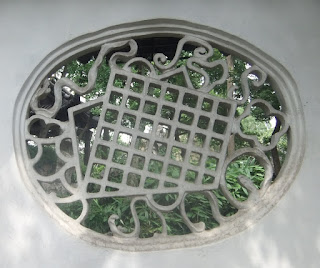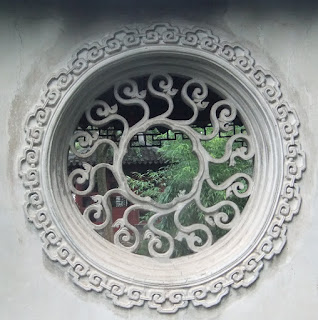Relief sculpture from below a bridge illustrating the patterned windows as part of the heritage of Soochow city.
The largest is the Garden of the Humble Administrator. It is the most famous but, as it happens, probably the least inspiring. Far better are some of the smaller gardens such as the Garden of the Master of Nets – the author took lodgings directly opposite this small garden and found it both beautiful and unique. Also worthwhile was the little-visited Garden of Couples – a lover’s garden – that is more compact and modest but appropriately intimate and romantic. Temples and other religious institutions were completely trashed during the Cultural Revolution – the most wanton outbreak of mass vandalism in history – but gardens largely emerged unscathed. Certainly, they were removed from private hands and placed under public control, and they were often turned into "fitness parks" for the ‘People’s Recreation’, but they generally remained as before. These days, some of the lost elements are being reconstituted. In the Garden of Couples, for instance, a public notice now explains to visitors – Chinese and foreign – that the ‘Book of Changes’ pavilion (a beautiful, quaint little building at the edge of a lotus pond) was used for a “type of Taoist fortunetelling once popular in the old days”.
If you are looking for traditional China and want to learn about the Chinese tradition, the People's Republic is not the place to go. You would find more of the authentic Chinese tradition in San Francisco. The Cultural Revolution was appallingly thorough. It is common to encounter Chinese with next to no knowledge of their cultural history. It is a country where religion was outlawed for an entire generation. The great Buddhist temple in Shanghai was turned into a plastics factory. Many Chinese have never even heard of Confucious. The Party, though, recently admitted for the first time that the Cultural Revolution was a "mistake" and have instituted a re-culturation program called "China Dream". It is only now that the Chinese people are slowly, slowly recovering something of what was lost.
If you are looking for traditional China and want to learn about the Chinese tradition, the People's Republic is not the place to go. You would find more of the authentic Chinese tradition in San Francisco. The Cultural Revolution was appallingly thorough. It is common to encounter Chinese with next to no knowledge of their cultural history. It is a country where religion was outlawed for an entire generation. The great Buddhist temple in Shanghai was turned into a plastics factory. Many Chinese have never even heard of Confucious. The Party, though, recently admitted for the first time that the Cultural Revolution was a "mistake" and have instituted a re-culturation program called "China Dream". It is only now that the Chinese people are slowly, slowly recovering something of what was lost.
* * *
Many posts ago, this present writer made mention of the similarities between the Chinese sense of geometric patterning and that of the Mohammedans. The garden windows of Soochow are, surely, another example. The writer, in fact, began his travels through the Middle Kingdom in the Mohammedan western provinces, following the silk road to Xi’an where one finds the oldest mosque in China. From there, he followed the Chinese Musoolmen tradition to Louyang, and then to other locations, and found to his own satisfaction that it extends all the way eastwards to Shanghai. There is no mosque in Soochow, but the city is near to Shanghai and there can be no doubt that Mohammedan influences, driven by trade, extended all the way from west to east, and could not have missed such a cultural centre.
There is no need to prove “influences” and “contact” though. It is enough to observe that many of the patterns that adorn the garden windows throughout the classical gardens of Soochow, and much loved by the Chinaman, are identical to favoured patterns used extensively in the Mohammedan tradition.
The author made some attempt to collect photographs of as many instances of these windows as possible, but there are simply too many. Most are rectangular, some are circular, some irregular. All are abstract and, thankfully, none are representational. Only a few designs are repeated. In most gardens every window has a unique pattern. They allow veiled views from one space into another. It will be noted that in a modern relief sculpture situated under a bridge on one of the main canals, the subject of which is the illustrious history of Soochow (see the picture at the top of this page), these geometric windows appear as if they are regarded as part of the city’s heritage. The appearance of these patterns on bus stops and the like is, of course, a modern affectation, but it does seem likely that the origins of many if not all of these designs extends back into the city’s past. This page (see below) features examples of the garden windows of Soochow. They are much to this author's taste.
Yours,
Yours,
Harper McAlpine Black






















